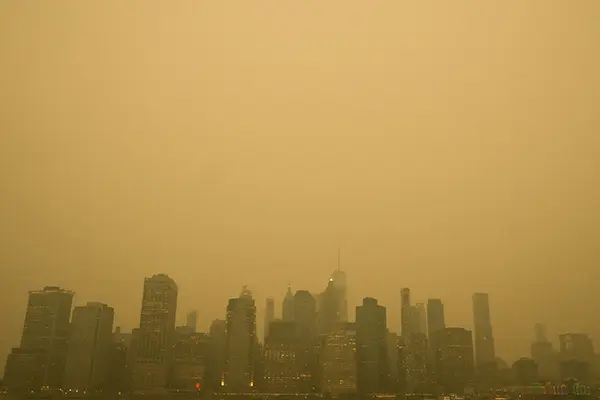Experts Point to Climate Change as Driver of Blazes
 Image by NYC Mayor Eric Adams/Twitter
Image by NYC Mayor Eric Adams/Twitter
06/09/2023
By Brooke Coupal
As wildfires raged in Canada, smoke billowed down into the eastern United States, leaving places like New York City and Washington, D.C., in a temporary orange haze.
Unusually hot and dry weather created a breeding ground for wildfires in provinces including Quebec, Nova Scotia and Ontario, with the Canadian Interagency Forest Fire Center recording more than 400 fires blazing at once. Vegetation became more combustible due to the warm temperatures and a lack of precipitation, so when lightning struck, some of those fires sparked.
Smoke from the wildfires traveled hundreds of miles down into the U.S. through the jet stream, which is a band of strong winds located in the upper atmosphere.
“When the smoke rises into the jet stream, it travels wherever the jet stream moves,” says Christopher Skinner, assistant professor in UMass Lowell’s Department of Environmental, Earth and Atmospheric Sciences (EEAS).
The smoke played a major role in the orange haze that some cities and towns in the U.S. witnessed. While blocking short wavelengths of light, such as blues and greens, the smoke let through longer wavelengths, including oranges and reds, Skinner explains.
“That’s why we’re left seeing the orange and red colors,” he says.
The smoke also affected air quality, as it contains gases like carbon dioxide and nitrogen oxide, as well as small particles that can enter people’s lungs and bloodstreams. The Massachusetts Department of Environmental Protection issued an air quality advisory Wednesday, alerting the public to watch for symptoms such as coughing and shortness of breath.
Such an advisory may be something we see more of in the future, EEAS Prof. Mathew Barlow says.
“As temperatures and precipitation variability increase in a warming climate, we can expect more of this kind of poor-to-terrible air quality from wildfire smoke,” he says.
EEAS Prof. Juliette Rooney-Varga, the director of the Climate Change Initiative, agrees.
“Climate change is making these kinds of events more likely,” she says.
And it’s a vicious cycle. When a wildfire sparks, it lets out carbon dioxide, a greenhouse gas that contributes to global warming. This in turn can cause extreme heat and drought, which are ideal conditions for wildfires.
To help prevent wildfires, Rooney-Varga says more needs to be done to mitigate climate change.
“Until we get our greenhouse gas emissions down to zero, we’re going to continue to see climate change, and we’re going to continue to see an increase in extreme weather and natural disasters,” she says. “We’re only going to mitigate climate change if we do so together.”


